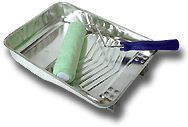JUST ROLL WITH IT!
Achieve a professional finish with less work!
Roll one on: Rollers are the tool of choice when painting large areas but they aren't all created equal. They come in a variety of lengths, fabric coverings and nap heights and just like great brushes, they can be used more than once. To achieve a professional finish with less work, you need to choose the proper roller for your project.
HERE'S WHAT TO LOOK FOR:
Lint Free: Here's a guaranteed little-known fact! Lint free rollers are great but it is still necessary to rinse with water before using latex paint or mineral spirits if using alkyd. This eliminates any loose fibres getting in your paint and primes your roller to except the paint faster. Who knew!
Pile Density: Just as in fine carpets, pile matters - the thicker the pile density the better the roller applies the paint. High pile rollers hold more paint resulting in a smoother finish and less time reloading your roller.
Seam Lines: Choose a roller that do not have conspicuous seam lines, otherwise you might end up with unplanned patterned walls.
The Ends: A good quality roller has tapered ends to prevent paint seeping inside the roller.
The Core: Want a roller that keeps its shape? Since cardboard cores soften and develop flat spots, choose a roller with a PVC plastic core.
With rollers, you really do get what you pay for. An inexpensive roller will mat or fail to evenly spread even the highest quality paints, and it may leave your walls feeling rough because of lint imbedded on your walls.
Be Cagey: Get a handle on your roller. A good roller cage, like Beauti-Tone's Rollerlock paint roller frame (1655-113), is built for pros. Its heavy duty construction features four wires, not three, a no-slip system to keep the roller from shifting, a strong handle to support the roller, and a high-quality connection at the base to support an extension pole.
ROLLER MUST HAVES
A roller cover (1656-840) keeps your roller ready to go if you can't finish your project in one day.
A roller and brush spinner (1610-360) cleans your brushes and rollers in seconds with no mess.
Brushes:
1. The length of the bristle. The longer the bristle the smoother the finish will be.
2. The quantity of bristles and bristles with flagged ends. This allows the brush to hold more paint which means less time going back to the can to reload.
3. Attachment of bristles. On a good quality brush the bristles are attached with epoxy and clamped. On poor quality brushes they may be simply stapled. This can result in more time spent picking bristles off the wall than painting.
4. The ferrule (metal banding around the brush). On better brushes, the banding is made of rust resistant metal.
Some points to keep in mind when buying paint brushes:
1. There are two general types of brushes - those made of synthetic materials and natural bristle brushes.
Synthetic bristle brushes are a good choice for all types of paint and recommended for latex or water-based paints.
Natural bristle brushes are good for oil or alkyd paints, and for fine enamel or varnish work. They are not suitable for latex painting, since the water will swell the bristles.
2. All high quality brushes share certain characteristics. Their bristles have split ends, which help produce a finer brush stroke. They are chiseled so that the tip of the brush tapers in and tends to be springy and well balanced. These brushes hold a lot of paint and permit even, accurate and effortless application.
Make sure you match the size and shape of the brush to the paint job.
Large exterior surfaces - 4" wide flat brush with a thickness of 3/4"-1" is best
Interior walls and ceilings - 3" wide brush
Window Frames, moldings, and woodwork - 1-2.5" in wide brush
Corners - brush with tapered edges.
Ask your local Home Hardware, Home Hardware Building Centre or Home Building Centre Dealer for advice on selecting the best application tool for the job.
paint-applicators
